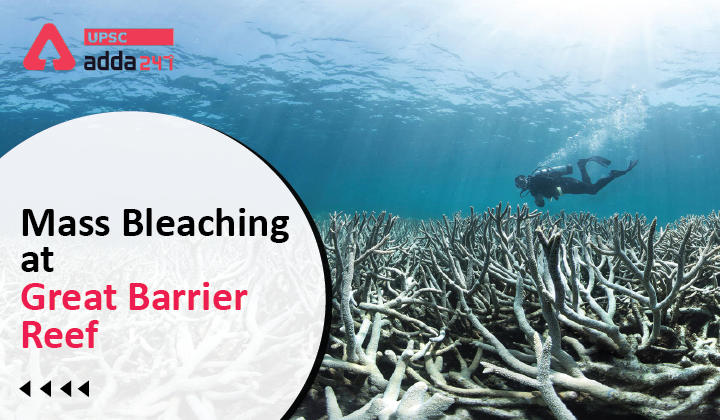Table of Contents
Great Barrier Reef: Relevance
- GS 3: Conservation, environmental pollution and degradation, environmental impact assessment.
Great Barrier Reef: Context
- Recently, the Great Barrier Reef Marine Park Authority of Australia has declared that the Great Barrier Reef is being devastated by another mass bleaching event.
- Read about Status of Coral Reefs of the World 2020
Great Barrier Reef: Key points
- It is the fourth time in six years that such severe and widespread damage of coral reefs has been detected.
- Importantly, only two mass bleaching events had ever been recorded until 2016.
- Scientists are especially concerned because bleaching event has occurred in the same year as a La Niña weather phenomenon. Typically, in Australia, a La Niña brings cooler temperatures.
- Scientists are now fearful of the damage that could be caused by the next El Niño.
Great Barrier Reef: What is mass bleaching?
- Coral bleaching is a common response of a coral under stress. Small patches of bleached coral are not necessarily a cause for concern.
- However, mass bleaching events span tens or even hundreds (and sometimes thousands) of kilometres that can affect entire ecosystems and are a significant cause for concern for all the stakeholders involved.
- Mass bleaching reason: Mass bleaching events are primarily triggered by sea temperatures exceeding the normal summer maximum for prolonged periods (weeks).
- Primary triggers: High water temperature and bright sunlight.
- Calm and clear conditions with minimal current can also exacerbate the stress and intensify bleaching.
- Lack of wind and currents may result in less mixing of water layers, clearer seas, and deeper penetration of solar irradiance.
Mass bleaching: Why the environmental scientists are worried?
- The frequency and severity of mass-bleaching events have been increasing over the last few decades, causing reef degradation at a global scale.
- These events are expected to occur even more often as sea-surface temperatures continue to rise under global climate change.
- This is the first time the reef has bleached under the cooling conditions of the natural La Niña weather pattern, which shows the long-term warming trend of climate change.
Great Barrier Reef
- The Great Barrier Reef is a site of remarkable variety and beauty on the north-east coast of Australia.
- It contains the world’s largest collection of coral reefs, with 400 types of coral, 1,500 species of fish and 4,000 types of mollusc.
- It also holds great scientific interest as the habitat of species such as the dugong (‘sea cow’) and the large green turtle, which are threatened with extinction.
Coral reefs significance
Economic significance
- The value of goods and services provided by coral reefs is estimated at US$2.7 trillion per year, including US$36 billion in coral reef tourism.
Ecological significance
- Coral reefs support at least 25% of marine species and underpin the safety, coastal protection, wellbeing, food and economic security of hundreds of millions of people.
- Soft corals bend and sway amongst the craggy mountains of hard corals providing additional homes for fish, snails and other marine creatures.
- Coral reefs harbour the highest biodiversity of any of the world’s ecosystems, making them one of the most biologically complex and valuable on the planet.
Also Read:





 TSPSC Group 1 Question Paper 2024, Downl...
TSPSC Group 1 Question Paper 2024, Downl...
 TSPSC Group 1 Answer key 2024 Out, Downl...
TSPSC Group 1 Answer key 2024 Out, Downl...
 UPSC Prelims 2024 Question Paper, Downlo...
UPSC Prelims 2024 Question Paper, Downlo...
